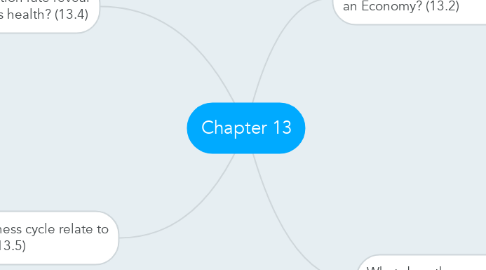Chapter 13
by Ann Mullen

1. How to economist measure the size of an Economy? (13.2)
1.1. The main measure of the economy is the GDP. GDP- stands for Gross Domestic Product. This is the market value of all final goods and services produced in a country within a given period of time. Market value- the price buyers are willing to pay for a good in a marketplace. Economist calculate GDP by measuring expenditures on goods and services produced in a country. Countries with higher GDP have shown to have a higher education rate. Literacy rate- the percentage of people in these countries who can read and write. Infant mortality- the rate at which babies die during their first year of life. The also use GDP to not only measure how big an economy is, but if it is growing or shrinking and at which rate.
2. What does the unemployment rate tell us about an economy's health? (13.3)
2.1. The unemployment rate is a useful indicator of the health of the economy. The government measures unemployment every month, the BLS reports a total number of people who are unemployed to the previous month. When an economy reaches full employment, jobs exist for everyone who wants a job, even though a certain percentage of those jobs and workers will not have been matched together. There are some problems with unemployment. The first problem is that at any time a number of unemployed people have given up looking for work. Unemployment rate- the percentage of the labor force that is seeking work. Underground economy- made up of people who earn money from gambling, drug dealing, and other illegal actions. Natural rate of unemployment- a certain percentage of workers and jobs that have not been matched yet. Involuntary part time workers- people who can not find a full time job so they settle for a part time job.
3. What does the inflation rate reveal about an economy's health? (13.4)
3.1. Economist at the BLS track changes in the cost of living using the consumer price index. Consumer price index- measures the average change in price of a type of good over time. The real cost of living- the nominal cost of basic goods and services, adjusted for inflation. This allows economist to calculate the real cost of goods and services in dollars. Since 1913, the average annual rate of inflation has been about 3.2 percent. For much of that period, the rate has varied widely. Creeping inflation- we have come to expect a certain amount of gradual inflation. The spending that makes up GDP comes from households, businesses, government, and foreign buyers. Demand pull inflation- The extra demand by buyers exerts a “pull” on prices, forcing them up.
4. How does the Business cycle relate to economic health? (13.5)
4.1. The recurring period of growth and decline in economic activity that all economies experience. Expansion- A period of economic growth. Business cycles are irregular in both length and severity. This makes peaks and troughs difficult to predict. Business cycles are popularly known as periods of boom and bust. A boom is the expansion phase of the cycle. It may also be known as a recovery, upturn, upswing, or period of prosperity. Some recessions are short and relatively mild in their effects. Depression- is a prolonged economic downturn characterized by a plunging real GDP and extremely high unemployment.


